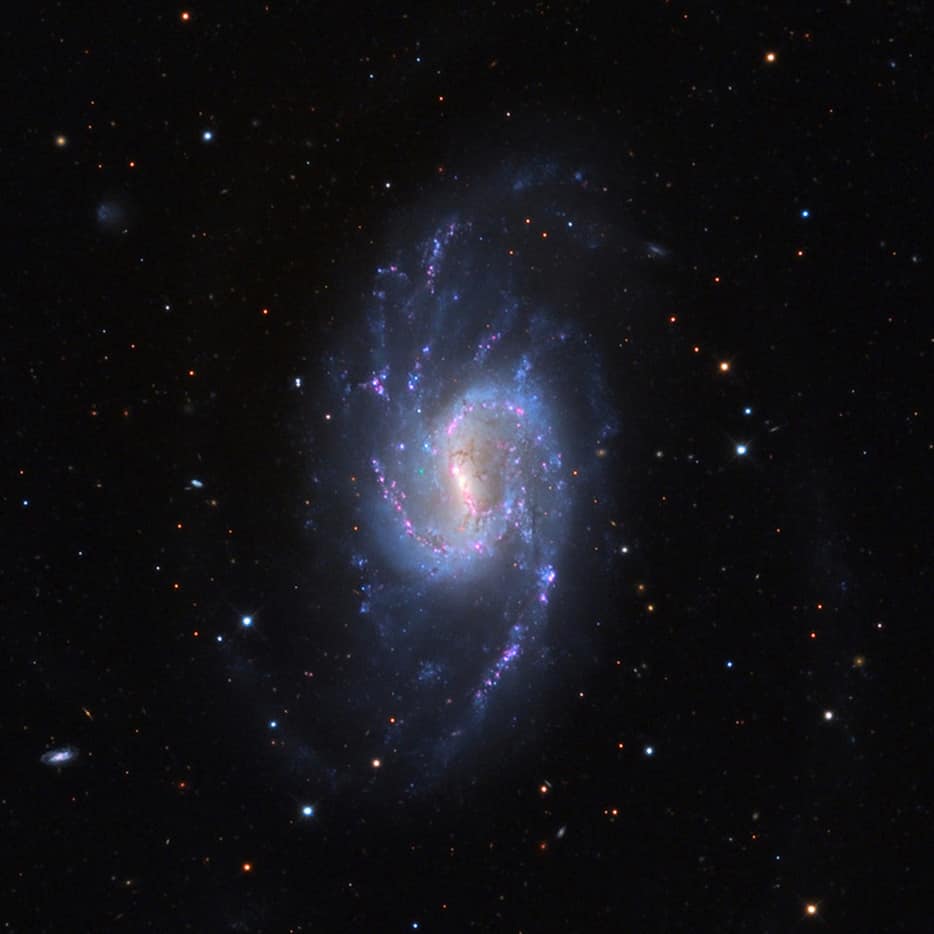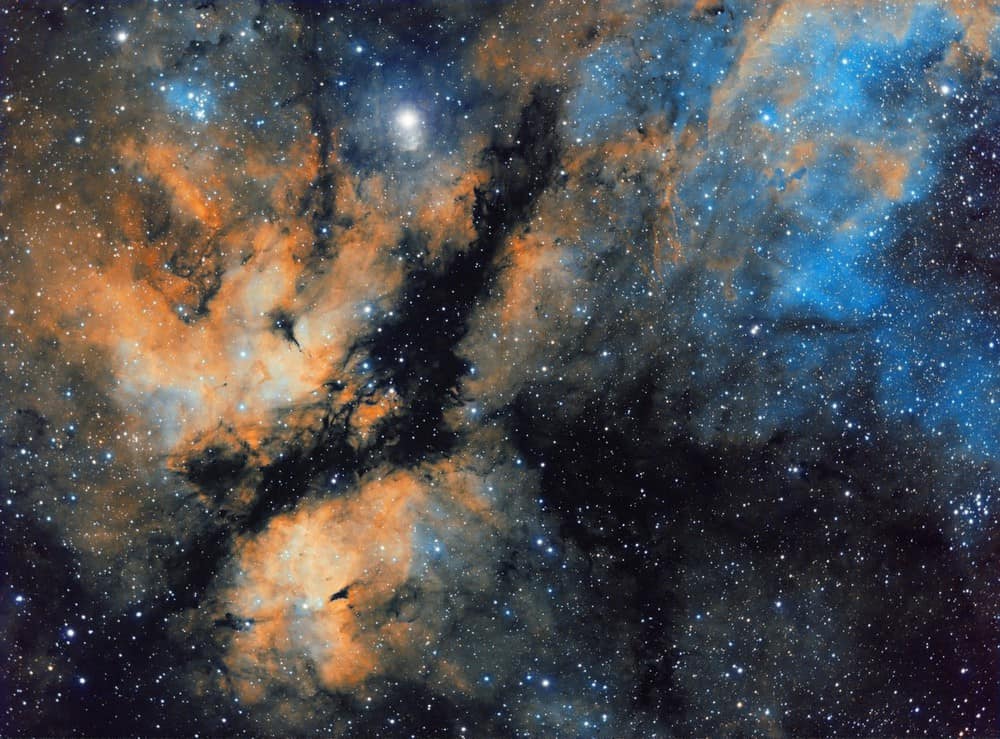Blog
NGC 2264 is the designation number of the New General Catalogue that identifies two astronomical objects as a single object: the Cone Nebula, and the Christmas Tree Cluster. Two other objects are within this designation but not officially included, the Snowflake Cluster, and the Fox Fur Nebula.
All of the objects are located in the Monoceros constellation and are located about 800 parsecs or 2600 light-years from Earth.
NGC 2264 is sometimes referred to as the Christmas Tree Cluster and the Cone Nebula. However, the designation of NGC 2264 in the New General Catalogue refers to both objects and not the cluster alone.
NGC2264 is the location where the Cone Nebula, The Stellar Snowflake Cluster and the Christmas Tree Cluster have formed in this emission nebula. For reference, the Stellar Snowflake Cluster is located 2,700 light years away in the constellation Monoceros. The Monoceros constellation is not typically visible by the naked eye due to its lack of colossal stars.

Raphael Homer “Ray” Bryant (December 24, 1931 – June 2, 2011) was an American jazz pianist, composer, and arranger.
Bryant was born in Philadelphia, Pennsylvania, on December 24, 1931. His mother was an ordained minister who had taught herself to play the piano; his father also played the piano and sang. His brothers were the bass player Tommy, drummer and singer Len, and Lynwood. Ray began playing the piano around the age of six or seven, following the example of his mother and his sister, Vera.
After three years working on and off in Collins’s band, Bryant toured with guitarist Tiny Grimes (1948–49). He was then a solo pianist based in Syracuse, New York for a year. After returning to Philadelphia, he played Dixieland in Billy Kretchmer’s club for around two years. He attracted more attention after becoming house pianist at the Blue Note club in Philadelphia in 1953.[3] He was there until 1956, accompanying many leading players such as Lester Young, Charlie Parker, Miles Davis, and Sonny Stitt.[5] Davis and Sonny Rollins both liked Bryant’s playing enough to record with him in New York in 1955: on Quintet/Sextet and Work Time, respectively.
These albums were for Prestige Records, for whom Bryant “began a period as an occasional house pianist”, also recording with “Art Taylor (1957), Tiny Grimes and Coleman Hawkins (both 1958–9), […] and as a leader (1957–8).” In this period, he was also the accompanist for singer Carmen McRae (1956–57). Bryant was also a member of trumpeter Dizzy Gillespie‘s small and big bands for four months in 1957. Bryant recorded under drummer Art Blakey for several studio-based albums in 1957–58. Decades later, he commented: “The sessions I recorded with him helped put me on the map as a musician”. Bryant was also part of drummer Jo Jones‘s trio in 1958. The pianist was able to learn a lot from Jones: “He could sense when you weren’t relaxed and would say, ‘Take your time and breathe!’ He also taught me about pacing a set. I still use his format today”, commented Bryant around 2004.
more...Irving Lee Dorsey (December 24, 1924 – December 1, 1986) was an American pop and R&B singer during the 1960s. His biggest hits were “Ya Ya” (1961) and “Working in the Coal Mine” (1966). Much of his work was produced by Allen Toussaint, with instrumental backing provided by The Meters.
Born in New Orleans, Louisiana, Dorsey was a childhood friend of Fats Domino before moving to Portland, Oregon when he was ten years old. He served in the United States Navy in World War II and then began a career in prizefighting. Boxing as a lightweight in Portland in the early 1950s, he fought under the name Kid Chocolate and was reasonably successful. He retired from boxing in 1955 and returned to New Orleans, where he opened an auto repair business as well as singing in clubs at night.
His first recording was “Rock Pretty Baby/Lonely Evening” on Cosimo Mattasa’s Rex label, in 1958. This was followed by the Allen Toussaint-produced “Lottie Mo/Lover of Love”, for the small Valiant label in late 1960 (picked up by ABC Paramount in 1961). These efforts were unsuccessful, but around 1960 he was discovered by A&R man Marshall Sehorn, who secured him a contract with Fury Records, owned by Bobby Robinson. After meeting songwriter and record producer Allen Toussaint at a party, he recorded “Ya Ya“, a song inspired by a group of children chanting nursery rhymes. It went to number seven on the Billboard Hot 100 in 1961, sold over one million copies, and was awarded a gold disc. Although the follow-up “Do-Re-Mi” also made the charts, later releases on Fury were not successful. Dorsey returned to running his repair business, but also released singles on the Smash and Constellation labels in 1963 and 1964.
more...Warren “Baby” Dodds (December 24, 1898 – February 14, 1959) was a jazz drummer born in New Orleans, Louisiana. He is regarded as one of the best jazz drummers of the pre-big band era, and one of the most important early jazz drummers. He varied his drum patterns with accents and flourishes, and he generally kept the beat with the bass drum while playing buzz rolls on the snare. Some of his early influences included Louis Cottrell, Sr., Harry Zeno, Henry Martin, and Tubby Hall. Dodds was among the first drummers to be recorded who improvised while performing.
“Baby” Dodds was the younger brother of clarinetist Johnny Dodds. His mother, who died when he was nine years old, taught him valuable lessons about persistence and putting one’s whole effort into endeavors, and he carried these with him through his career as a jazz drummer. He was born into a very musical family. His father and uncle played violin and his sister played harmonica. In addition, his father was religious and the family regularly sang hymns together.
Dodds gained a reputation as a top young drummer in New Orleans. In 1918, Dodds left Sonny Celestin’s outfit to play in Fate Marable‘s riverboat band. A young Louis Armstrong also joined the band, and the two of them were on the boats for three years (from 1918 to 1921). The band played on four different boats, and usually left New Orleans in May and travel to St. Louis, though they also sometimes traveled further north. They played jazz, popular, and classical music while on the boats. Dodds and Armstrong left Fate Marable’s band in 1921 due to a disagreement about musical style, and Dodds soon joined King Oliver’s Creole Jazz Band. At this time, the personnel in Oliver’s band were Joe “King” Oliver on cornet, Baby Dodds’ brother Johnny Dodds on clarinet, Davey Jones on alto saxophone, Honoré Dutrey on trombone, Lil Hardin on piano, Jimmy Palao on violin, and Eddie Garland on bass fiddle. They moved to California in 1921 to work with Oliver there, and they played together for about fifteen months. In 1922, the band, excepting Garland, Palao, and Jones, followed Oliver to Chicago, which would be his base of operations for several years. They began playing at the Lincoln Gardens, and Louis Armstrong also joined this outfit. Dodds describes playing with this band as “a beautiful experience”. Dodds recorded with Louis Armstrong, Jelly Roll Morton, Art Hodes, and his brother Johnny Dodds. Dodds played in Louis Armstrong’s Hot Five and Hot Seven groups. In May 1927 Armstrong recorded with the Hot Seven, which consisted of Johnny Dodds, Johnny St. Cyr, Lil Hardin Armstrong, John Thomas, Pete Briggs, and Baby Dodds.[6] From September to December 1927 the Hot Five Armstrong assembled consisted of Johnny Dodds, Kid Ory, Johnny St. Cyr, Lonnie Johnson, and Baby Dodds.
more...https://www.youtube.com/watch?v=dDmI0XfHuuM
more...Git dat Zip pa de doo da thang goin’!
Santa or Jesus; the dynamic duo of jolly! Will the real Heavenly Father please stand up!

NGC 3359 is a galaxy located 49 million light years from Earth. The central bar is approximately 500 million years old.
NGC is “devouring” the much smaller galaxy, nicknamed the Little Cub.

James Timothy Hardin (December 23, 1941 – December 29, 1980) was an American folk musician and composer. He wrote the Top 40 hit “If I Were a Carpenter“, covered by, among others, Bobby Darin, Bob Dylan, Bob Seger, Joan Baez, Johnny Cash, The Four Tops, Robert Plant, Small Faces, Johnny Rivers, and Bert Jansch; his song “Reason to Believe” has also been covered by many artists, notably Rod Stewart (who had a chart hit with the song), Neil Young, and The Carpenters. Hardin is also known for his own recording career.
Hardin was born in Eugene, Oregon, and attended South Eugene High School. He dropped out of high school at age 18 to join the Marine Corps. Hardin is said to have discovered heroin while posted in Southeast Asia.
After his discharge he moved to New York City in 1961, where he briefly attended the American Academy of Dramatic Arts. He was excluded owing to truancy and began to focus on his musical career by performing around Greenwich Village, mostly in a blues style.
After moving to Boston in 1963 he was discovered by the record producer Erik Jacobsen (later the producer for The Lovin’ Spoonful), who arranged a meeting with Columbia Records. In 1964 he moved back to Greenwich Village to record for his contract with Columbia. The resulting recordings were not released and Columbia terminated Hardin’s recording contract.
more...Jorma Ludwik Kaukonen, Jr. (/ˈjɔːrmə ˈkaʊkənɛn/; YOR-mə KOW-kə-nen; born December 23, 1940) is an American blues, folk, and rockguitarist. Kaukonen performed with Jefferson Airplane and still performs regularly on tour with Hot Tuna, which started as a side project with bassist Jack Casady, and as of early 2019 has continued for 50 years. Rolling Stone magazine ranked him #54 on its list of 100 Greatest Guitarists.
Jorma Kaukonen was born in Washington, DC to Beatrice Love (née Levine) and Jorma Ludwik Kaukonen, Sr. He had Finnish paternal grandparents and Russian Jewish ancestry on his mother’s side.[10] During his childhood, Jorma’s family lived in Pakistan, the Philippines and other locales as he followed his father’s State Department career from assignment to assignment before returning to the place of his birth. As a teenager in Washington, he and friend Jack Casady formed a band called The Triumphs, with Kaukonen on rhythm guitar and Casady on lead.
In 1965, friend and classmate Paul Kantner invited Kaukonen to join a rock band he was forming with Marty Balin. As a self-described blues purist, Kaukonen was initially reluctant, but found his imagination excited by the arsenal of effects available to electric guitar, later remarking that he was “sucked in by technology.” With the group still looking for a name, Kaukonen suggested the name Jefferson Airplane, inspired by an eccentric friend who had given his dog the name “Blind Lemon Jefferson Airplane.” When their original bass player was fired, Kaukonen recommended his friend Jack Casady (who still lived in Washington D.C. at the time) as a replacement.
Though never a prolific singer or songwriter during his Airplane tenure, Kaukonen contributed material to each of the group’s albums; Most notably, the instrumental “Embryonic Journey,” an arrangement of “Good Shepherd,” “Third Week in the Chelsea” (which detailed his feelings about the disintegration of the band) and “Trial by Fire“—all of which he continues to play. In 1969–70, Kaukonen and Jack Casady formed Hot Tuna, a spinoff group that allowed them to play as long as they liked. An early incarnation of Hot Tuna included Jefferson Airplane vocalist Marty Balin and featured Joey Covington on drums and vocals. This grouping came to an end after an unsuccessful recording jaunt to Jamaica, the sessions of which have never been released. Pared down to Kaukonen and Casady, Hot Tuna lived on as a vehicle for Kaukonen to show off his Piedmont-style acoustic blues fingerpicking skills.
more...Frank Morgan (December 23, 1933 – December 14, 2007) was a jazz saxophonist with a career spanning more than 50 years.[1] He mainly played alto saxophone but also played soprano saxophone. He was known as a Charlie Parker successor who primarily played bebop and ballads.
Frank Morgan was born in Minneapolis, Minnesota in 1933, but spent most of his childhood living with his grandmother in Milwaukee, Wisconsin while his parents were on tour. Morgan’s father Stanley was a guitarist with Harlan Leonard and the Rockets and The Ink Spots, and his mother, Geraldine, was a 14-year-old student when she gave birth to him. Morgan took up his father’s instrument at an early age, but lost interest the moment he saw Charlie Parker take his first solo with the Jay McShann band at the Paradise Theater in Detroit, Michigan. Stanley introduced them backstage, where Parker offered Morgan advice about starting out on the alto sax, and they met at a music store the following day. As a teenager Morgan had opportunities to jam with the likes of Dexter Gordon and Wardell Gray on Sunday afternoons at the Crystal Tearoom. When he was just 15 years old, Morgan was offered Johnny Hodges‘s spot in Duke Ellington‘s Orchestra, but Stanley deemed him too young for touring. Instead he joined the house band at Club Alabam where he backed vocal luminaries such as Billie Holiday and Josephine Baker. That same year he won a television talent-show contest, the prize of which was a recording session with the Freddy Martin Orchestra, playing “Over the Rainbow” in an arrangement by Ray Conniff, with vocals by Merv Griffin. Morgan attended Jefferson High School during the day, where he played in the school big band that also spawned jazz greats Art Farmer, Ed Thigpen, Chico Hamilton, Sonny Criss, and Dexter Gordon. Morgan stayed in contact with Parker during these years, finding himself in jam sessions at Hollywoodcelebrities’ homes when Parker visited L.A. In 1952, Morgan earned a spot in Lionel Hampton‘s band, but his first arrest in 1953 prevented him from joining the Clifford Brown and Max Roachquintet (that role went instead to Harold Land, and later, Sonny Rollins). He made his recording debut on February 20, 1953 with Teddy Charles and his West Coasters in a session for Prestige Records. This sextet featured short-lived tenor player Wardell Gray and was included on the 1983 posthumous release Wardell Gray Memorial Volume 1. On November 1, 1954, Morgan cut five tracks with the Kenny Clarke Sextet for Savoy Records, four of which were released with Clarke billed as the leader, with “I’ve Lost Your Love” credited to writer Milt Jackson as leader.Morgan recorded an all-star date with Wild Bill Davis and Conte Candoli on January 29, 1955 and participated in a second recording session on March 31, 1955 with Candoli, Wardell Gray, Leroy Vinnegar and others, which were combined and released in 1955 as Morgan’s first album, Frank Morgan, by GNP Crescendo Records. Later releases also included five tracks cut at the Crescendo Club in West Hollywood on August 11, 1956 with a sextet featuring Bobby Timmons and Jack Sheldon. The album copy hailed Morgan as the new Charlie Parker, who had died the same year. In his own words, Morgan was “scared to death” by this and “self-destructed.”
more...Chesney Henry Baker Jr. (December 23, 1929 – May 13, 1988) was an American jazz trumpeter and vocalist.
Baker earned much attention and critical praise through the 1950s, particularly for albums featuring his vocals (Chet Baker Sings, It Could Happen to You). Jazz historian Dave Gelly described the promise of Baker’s early career as “James Dean, Sinatra, and Bix, rolled into one.” His well-publicized drug habit also drove his notoriety and fame. Baker was in and out of jail frequently before enjoying a career resurgence in the late 1970s and ’80s. Baker was born and raised in a musical household in Yale, Oklahoma. His father, Chesney Baker Sr., was a professional guitarist, and his mother, Vera Moser, was a pianist who worked in a perfume factory. His maternal grandmother was Norwegian. Baker said that due to the Great Depression, his father, though talented, had to quit as a musician and take a regular job.
Baker performed with Vido Musso and Stan Getz before being chosen by Charlie Parker for a series of West Coast engagements. In 1952, Baker joined the Gerry Mulligan Quartet. Rather than playing identical melody lines in unison like Parker and Dizzy Gillespie, Baker and Mulligan complemented each other with counterpoint and anticipating what the other would play next. “My Funny Valentine“, with a solo by Baker, became a hit and would be associated with Baker for the rest of his career. With the Quartet, Baker was a regular performer at Los Angeles jazz clubs such as The Haig and the Tiffany Club.
Within a year, Mulligan was arrested and imprisoned on drug charges. Baker formed a quartet with a rotation that included pianist Russ Freeman, bassists Bob Whitlock, Carson Smith, Joe Mondragon, and Jimmy Bond, and drummers Larry Bunker, Bob Neel, and Shelly Manne. Baker’s quartet released popular albums between 1953 and 1956. Baker won reader’s polls at Metronomeand Down Beat magazine, beating trumpeters Miles Davis and Clifford Brown. In 1954, readers named Baker the top jazz vocalist. In 1956, Pacific Jazz Records released Chet Baker Sings, an album that increased his visibility and drew criticism. Nevertheless, Baker sang throughout the rest of his career.
https://www.youtube.com/watch?v=yNGYr_ribPQ
Butterfly Nebula in narrow band image SHO image by Stephan Hamel.
NGC 6302, also called the Bug Nebula or Butterfly Nebula, is a bipolar planetary nebula in the constellation Scorpius. The structure in the nebula is among the most complex ever observed in planetary nebulae. The spectrum of NGC 6302 shows that its central star is one of the hottest stars known, with a surface temperature in excess of 250,000 degrees Celsius, implying that the star from which it formed must have been very large.
The central star, a white dwarf, was identified in 2009, using the upgraded Wide Field Camera 3 on board the Hubble Space Telescope. The star has a current mass of around 0.64 solar masses. It is surrounded by a dense equatorial disc composed of gas and dust. This dense disc is postulated to have caused the star’s outflows to form a bipolar structure similar to an hourglass. This bipolar structure shows features such as ionization walls, knots and sharp edges to the lobes.

John Patitucci (born December 22, 1959) is an American jazz bassist and composer. John James Patitucci was born in Brooklyn, New York, on December 22, 1959. When he was 12 he bought his first bass and decided on his career. He listened to bass parts in R&B songs on the radio and on his grandfather’s jazz records. He cites as influences Oscar Peterson‘s albums with Ray Brown and Wes Montgomery‘s with Ron Carter. For the development of rhythm, he points to the time he has spent with Danilo Pérez, a pianist from Panama.
In the late 1970s he studied acoustic bass at San Francisco State University and Long Beach State University. He began his professional career when he moved to Los Angeles in 1980 and made connections with Henry Mancini, Dave Grusin, and Tom Scott. From the mid-1980s to the mid-1990s he was a member of three Chick Corea groups: the Elektric Band, the Akoustic Band, and the quartet. As a leader he formed a trio with Joey Calderazzo and Peter Erskine, and a quartet with Vinnie Colaiuta, Steve Tavaglione, and John Beasley. He has played with Herbie Hancock, Wayne Shorter, and Roy Haynes. Patitucci switches between acoustic and electric bass (double bass and bass guitar).
He was artistic director of the Bass Collective, a school for bassists in New York City, and he is involved with the Thelonious Monk Institute of Jazz and the Betty Carter Jazz Ahead program. He was Professor of Jazz Studies at City College of New York. In June 2012 he started the Online Jazz Bass School. He was appointed artist in residence at Berklee College of Music.
more...Lil Green (December 22, 1919 (some sources give 1901 or 1910) – April 14, 1954) was an American blues singer and songwriter. She was among the leading female rhythm and blues singers of the 1940s, with a sensual soprano voice. Gospel singer R.H. Harris has lauded her voice, and her interpretation of religious songs
Originally named Lillian Green or Lillie May Johnson, she was born in Mississippi. After the early deaths of her parents, she began performing in her teens and, having (like many African-American singers) honed her craft in the church performing gospel, she sang in Mississippi jukes, before heading to Chicago, Illinois, in 1929, where she would make all of her recordings.
Green was noted for superb timing and a distinctively sinuous voice. She was reportedly 18 when she recorded her first session for the 35-cent Bluebird subsidiary of RCA. In the 1930s she and Big Bill Broonzy had a nightclub act together. Her two biggest hits were her own composition “Romance in the Dark” (1940), which was later covered by many artists, such as Dinah Washington and Nina Simone (in 1967) (Billie Holidayrecorded a different song with the same title), and Green’s 1941 version of Kansas Joe McCoy‘s minor-key blues- and jazz-influenced song “Why Don’t You Do Right?“, which was covered by Peggy Lee in 1942 and many others since. As well as performing in Chicago nightclubs, Green toured with Tiny Bradshaw and other bands but never broke away from the black theatre circuit.
By 1949, Green had changed direction with the foresight to become a jazz vocalist, and tried to emulate the Jazz style of Billie Holiday. She signed with Atlantic Records in 1951, but at this point was already in poor health. She died of pneumonia in Chicago in 1954 and is buried in Oak Hill Cemetery, in Gary, Indiana.
more...Reunald Jones Sr. (December 22, 1910 – February 26, 1989), was a jazz trumpeter who worked both in big bands and as a studio musician.
Jones was born in Indianapolis. He studied at the Michigan Conservatory, and then played with territory bands such as that of Speed Webb. In the 1930s and 1940s Jones worked with musicians such as Charlie Johnson, the Savoy Bearcats, Fess Williams, Chick Webb (1933–34), Sam Wooding, Claude Hopkins, Willie Bryant, Teddy Hill, Don Redman (1936–38), Erskine Hawkins, Duke Ellington (1946), Jimmie Lunceford, Lucky Millinder and Sy Oliver. He soloed sparingly after his time with Chick Webb.
He played lead trumpet with the Count Basie Orchestra (1952–57), which gave him some fame due to his “one-handed” solo style of playing, but Jones was rarely featured.
However, Jones was featured as a member of the Quincy Jones group, “The Jones Boys” (56-58), a session conceived by Leonard Feather featuring a number of musicians named “Jones,” though none of them were related.
From the 1940s Jones did extensive work as a studio musician. He toured with Woody Herman (1959), George Shearing‘s big band (ca. 1960) and with an orchestra accompanying Nat King Cole(1961–64). He played less from the 1970s. His son, Reunald Jones Jr, played lead trumpet many years for Sammy Davis Jr & James Brown, and his grandson, Renny Jones, is an accomplished bass guitar player.
more...More Posts
- Don Pullen
- Bob James
- Cab Calloway
- World Music from Jerusalem
- Daily Roots Carlene Davis
- Merry Christmas Eve 2022
- Cosmos NGC 1805
- Dave Bartholomew
- Woody Shaw
- Ray Bryant
- Lee Dorsey
- Baby Dodds
- World Music Andelucious Ensemble from Jerusalem
- Daily Roots FITRI ALFIANA
- Flamenco Fridays Rocio Luna y Rubén Lara
- Cosmos NGC 1365
- Tim Hardin
- Jorma Kaukonen
- Esther Phillips
- Frank Morgan
